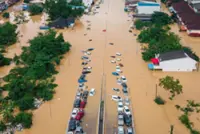The writer at Batu Pandang Ratapan Angin, which offers an obstructed view of the magnificent Dieng Plateau. — Photos: JOHAN JAAFFAR
I am convinced that most Malaysians have never heard of Desa Sembungan, believed to be the highest village on the Indonesian island of Java.
At about 2,450m above sea level, the temperature hovers around 24°C during the day and dips to 12°C at night. Between the months of October and May it could be as cold as 7°C at night.
There have even been records of sub-zero temperatures in the area. In July 2018, for instance, temperatures breached -2°C!
Legend has it that there was even a month-long night with thin ice and frost. This will give you an idea of just how unique and special Desa Sembungan is. Imagine England’s Lake District in the heart of Java.
When I was there in February, the lowest temperature recorded at night was 13°C; it was rainy and foggy.
There are 1,215 souls living in this village, mostly farmers who plant potatoes, onions and cabbages. It is also home to “carica” or mountain papaya. Carica is so popular here that it has become a home-grown industry, where the fruits are processed into health supplements.
You can, of course, eat the fruit as is, because it is known to have many health benefits.
Pariwisata or tourism is contributing substantially to the local economy. In some months of the year, Sembungan is packed with tourists. Those are good months for the locals.
Sembungan is situated in the Kejajar district (known as kecamatan in Bahasa Indonesia) in the Wonosobo regency (or kabupaten) in Central Java. The village is part of a massive volcanic complex known for its mountains, craters, lakes and historical sites – the Dieng Plateau (Tanah Tinggi Dieng).
For trekkers and climbers, the Dieng Plateau is heaven on Earth. It is where you can find some of the best treks in Central Java. Many of the well-known mountains are there, including Prau (2,600m), Pakuwaja (2,390m), Bisma (2,365m), Pangonan (2,308m), Sikunir (2,275m), Sipandu (2,240m), and Rogojembangan (2,177m) to name a few.
From any of the vantage points around the area one can view two of the most famous and spectacular mountains, Sindoro (3,136m), and its twin, Sumbing (3,371m) – the latter is the third highest peak on Java Island, after Semeru (3,676m).
My intention was to avoid the trafik wisata (tourist traffic) thus I chose February to visit, but it was a bad choice. I had wanted to climb at least two of the peaks – Prau and Bisma – but the rain disrupted my plans.
Some of the basecamps are even closed. However, after much pleading, the local officials allowed me to try and hike to Bisma, though it came with many conditions. One of them was to check my blood pressure at intervals of 20 minutes at the basecamp before I started my climb.
They probably didn’t want a 71-year-old man to be a burden to their guides!
Bisma is supposed to be a relatively easy route but then on the day of my scheduled ascent it rained heavily the whole day.
So, someone suggested I try the Pangonan trek the next day, and I did. It was drizzling that morning, making the well-kept treks around Pangonan – from Karangsari Basecamp to Candi Gatotkaca – difficult. It was supposed to be a leisurely walk: In fact, compared to my Langtang Valley adventure in Nepal last September, it should have been a walk in the park.
However, it was wet, slippery, cold and tough, not to mention infested with leeches.
Still, the four-hour walk was worth it and compensated for my failure to summit the peaks of Prau and Bisma.
For me the real catch is Prau – so called because of its boat shape (perahu). Said to be a relatively easy route, this trek can be treacherous during rainy seasons.
The route via Patak Banteng is the most popular one and normally congested in some areas during peak seasons. I was told that Prau has the best views in Central Java for any mountain below 3,000m.
Rain conspired against me again when I attempted to catch the sunrise on Sikunir Hill one morning. Luckily, the weather eased up in the next two days, though there were some intermittent rain showers.
The fair weather gave me the chance to explore Batu Pandang Ratapan Angin en route to Sikunir Hill. From its highest point, you will have an unobstructed view of some of the region’s most spectacular sites like the Telaga Warna lake and many of the peaks nearby. As the name suggests, the lake water changes colour – red, green, blue and yellow – because of its sulphuric condiments.
There are many trekking trails in the Dieng Plateau that you can explore, provided you have the right guide to help you meander through lush forests, savannahs, colourful lakes, hissing craters and bubbling mud.
Near the village of Pekasiran, for example, is Telaga Dringo, an active crater. There’s also Kawah Sinila, where, not too far from there, 149 people died of gas poisoning in 1979.
Meanwhile, Kawah Candradimuka is a pool of bubbling hot mud and water that emits sulphurous gases without warning.
There are numerous candi or temples all over the area too, one of which dates back to the Kalinga Kingdom of the 7th and 8th centuries. The biggest candi is the Arjuna Hindu complex near the town of Dieng itself.
But Sembungan is the true gem of any Dieng adventure. And I think Sembungan should be on the bucket list of trekkers, especially those who are my age. It is a beautiful village perched in the clouds.
For the cold weather, the fog and the occasional rain, not to mention the natural vistas and friendly faces of its people, Sembungan is a place where you can experience a different side of Java ... or in fact, even a different side of Indonesia.
The views expressed here are entirely the writer’s own.
Johan Jaaffar is an avid trekker and mountaineer. He was part of a Langtang Valley expedition in Nepal last September.









